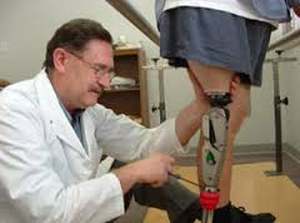

MedFriendly®


Orthotist-Prosthetist
An orthotist is a healthcare provider who specializes in
making orthoses. Orthoses are devices used to brace,
align, support, prevent, or correct deformities of the
body or to improve functional movement of specific
body parts. A prosthetist is someone who is skilled in
measuring, designing, making, fitting, adjusting, and
fixing prostheses, which are artificial replacements for
improving the appearance and function of damaged,
diseased, deformed, or missing body parts (typically an
arm or a leg).
FEATURED BOOK: Introduction to Orthotics
Body parts may be missing/ due to either an amputation (often from an accident, injury
during combat, or disease) or birth defect (i.e., missing body part). The art and science of
making prostheses is known as prosthetics. The difference between an orthosis and a
prosthesis is that an orthosis is used on an existing body part where a prosthesis is used
to replace a missing body part.
Prosthetists need to develop a socket that fits into the residual tissue. This residual
tissue area is scientifically referred to as the residuum and casually referred to as a
stump. The socket is usually made by glass or carbon fiber that is infused with acrylic
resin (a type of plastic). In some cases the socket is made by making a plastic mold over
a model of the stump. The socket is then connected to an assembly of the missing limb. In
the case of an above the knee amputation, the socket is connected to an artificial knee.
These elements are usually connected with an aluminum tube with devices that provide
alignment at each end.
"Where Medical Information is Easy to Understand"™
A leg prosthesis is connected at the other end to the ankle.
Prostheses allow for proper weight support with the least possible side
to side force impacting it. The prosthesis is aligned by the prosthetist
while the patient is walking to fix any gait (walking) abnormalities for
the best movement when the leg is in the air and for a good position
when the heel strikes the ground or when the toes push off the ground.
A health care provider can be an orthotist, prosthetist, or both. The
two fields are often spoke of together as O&P. People can become
board certified in this either area by passing an examination and
credential review (i.e., education and training background) through the
American Board for Certification in Orthotics, Prosthetics &
Pedorthics (pedorthics refers to modified footwear).
Board certified means that the practitioner has been deemed to be capable by one’s peers of advanced
specialty practice in a particular area. Board certification in this area is maintained through mandated
continuing education and following a code of professional responsibility. A certified orthotist is known as a
CO and a certified prosthetist is known as a CP. Orthotists and prosthetists do their work after an orthosis
or prosthesis is ordered by a medical doctor, nurse practitioner, or physician assistant. Orthotist comes
from the Greek word “orthosis” meaning “making straight.” Prosthetist comes from the Greek word
"prosthesis" meaning "an addition."

Fitting an artificial leg.














